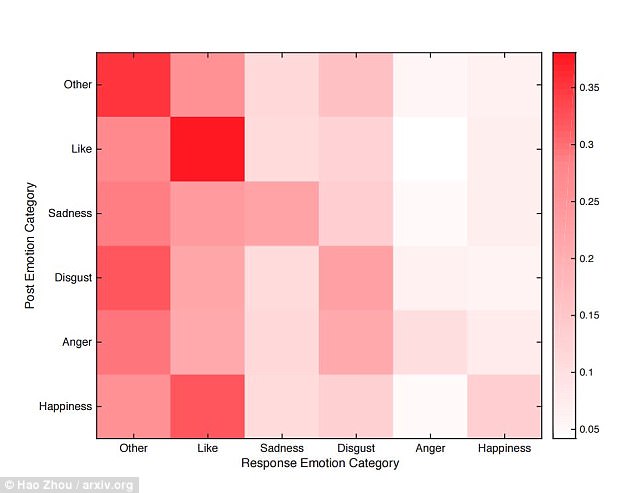Research: if the buyer understands that he is talking with the chat bot, then the purchase will not take place at all
There is no time to explain, here are the main postulates of today's translation:
Under the cut - research details and insights from scientists. Enjoy reading!

From Sephore and Amazon to Dominos Pizza, tech giants use chatbots to interact with millions of customers around the world. These AI systems have almost no marginal cost and can sell 4 times more than the "live" operators. However, a recent study showed that when the buyer realizes that he is talking to the robot, he becomes less inclined to buy, as the robot seems to him both less knowledgeable and less empathetic.
Chatbots is a conversational AI created to simplify human-computer communication and is used today in customer service. Many service companies use this technology in order to reduce the load when communicating with thousands / millions of customers around the world.
AI uses voice commands or chat and, as already noted, is economically extremely profitable. And here a reasonable question arises: why are robots not used as often as they could?


Sephore (left) and Amazon (right) use chatbots to communicate with customers.
A group of researchers decided to find the answer to this question and found out that communication between a car and a person reduces the likelihood of buying by more than 79.7% when a person understands who he is talking to.
The study included more than 6,200 customers of a financial services company. Clients were randomly assigned to live operators and chat bots, while clients were either not informed at all what they were talking with the robot, or they were talking about this at the beginning / end of the conversation, and also after a completed purchase.
“The results show that when people do not know what they are saying with AI, chatbots sell 4 times more efficiently than inexperienced employees, but when the subjects were aware that they were not talking to a person, they were laconic and even harsh. At the same time, they bought less, because the chat bot, in their opinion, is less empathetic, ”says Xueming Luo , a professor at Temple University . “Chatbots have technological advantages, reduce unproductive costs associated with customers and increase their well-being (because they can offer products at better prices, since bots can save on labor),” adds Luo. “The data obtained in the study will allow marketers to work with a specific user segment in order to develop consumer confidence in bots.”
Although people may not trust modern chatbots, scientists are working on technology that will allow such AI to better understand the connection between language and feelings. This can lead to more savvy helpers like Siri or Alexa, as well as laying the foundation for creating emotional robots.

Researchers have created an emotionally competent bot called ECM (Emotional Chatting Machine), which can respond to messages based on the mood of the interlocutor.
ECM created a team of Chinese researchers at Tsinghua University in Beijing and the University of Illinois . Their goal was to create a bot capable of responding not only relevantly and competently, but also with adequate emotional flow. At the moment, users must choose their own state - happiness, sadness, disgust or anger - but in the future, AI will be able to determine this on their own. As a result, it turned out that 61% of the subjects preferred the answers of this system to the answers of a regular chat bot.
Speaking to the Guardian, Professor Björn Schuller of Imperial College London said: “Sooner rather than later, the next generation of intelligence is coming, with which we will interact daily. And now the question is not whether such a technology is needed or not - it is obvious what is needed - and in which applications it makes sense to apply it. ”

ECM processed the dataset with millions of real conversations, each of which was labeled in one of 6 categories - “anger”, “disgust”, “happiness”, “approval”, “sadness” and “other”.
By teaching ECM the emotional color of messages, it becomes possible to teach him how to adapt his own replicas. The dataset was formed from 23,000 offers from Weibo, a Chinese social network. Each message was manually marked with one of 8 markers: “anger”, “disgust”, “fear”, “happiness”, “approval”, “sadness”, “surprise” and “other”. “Fear” and “surprise” were ignored, as there were too few examples in these categories; the remaining categories formed the dataset.
Having learned the manner in which each of the categories expresses itself, ECM has become able to apply emotional coloring in real-time communication. For example, if the phrase “Worst day in my life, I was late due to traffic jams” is sent to the entrance, then a regular chat bot will reply “You are late.” ECM offered other answers, for example, “I am always there to support you” (approval), “Smile!” Everything will be fine ”(happiness),“ It depresses (sadness), “Sometimes life sucks” (disgust), “Nightmare traffic jams” (anger).
- chat bots have no marginal costs and sell 4 times more than people;
- the probability of selling falls by 79% if people understand that they are talking to the robot;
- consumers perceive robots as less competent and empathic.
Under the cut - research details and insights from scientists. Enjoy reading!

From Sephore and Amazon to Dominos Pizza, tech giants use chatbots to interact with millions of customers around the world. These AI systems have almost no marginal cost and can sell 4 times more than the "live" operators. However, a recent study showed that when the buyer realizes that he is talking to the robot, he becomes less inclined to buy, as the robot seems to him both less knowledgeable and less empathetic.
Chatbots is a conversational AI created to simplify human-computer communication and is used today in customer service. Many service companies use this technology in order to reduce the load when communicating with thousands / millions of customers around the world.
AI uses voice commands or chat and, as already noted, is economically extremely profitable. And here a reasonable question arises: why are robots not used as often as they could?


Sephore (left) and Amazon (right) use chatbots to communicate with customers.
A group of researchers decided to find the answer to this question and found out that communication between a car and a person reduces the likelihood of buying by more than 79.7% when a person understands who he is talking to.
The study included more than 6,200 customers of a financial services company. Clients were randomly assigned to live operators and chat bots, while clients were either not informed at all what they were talking with the robot, or they were talking about this at the beginning / end of the conversation, and also after a completed purchase.
“The results show that when people do not know what they are saying with AI, chatbots sell 4 times more efficiently than inexperienced employees, but when the subjects were aware that they were not talking to a person, they were laconic and even harsh. At the same time, they bought less, because the chat bot, in their opinion, is less empathetic, ”says Xueming Luo , a professor at Temple University . “Chatbots have technological advantages, reduce unproductive costs associated with customers and increase their well-being (because they can offer products at better prices, since bots can save on labor),” adds Luo. “The data obtained in the study will allow marketers to work with a specific user segment in order to develop consumer confidence in bots.”
Although people may not trust modern chatbots, scientists are working on technology that will allow such AI to better understand the connection between language and feelings. This can lead to more savvy helpers like Siri or Alexa, as well as laying the foundation for creating emotional robots.

Researchers have created an emotionally competent bot called ECM (Emotional Chatting Machine), which can respond to messages based on the mood of the interlocutor.
ECM created a team of Chinese researchers at Tsinghua University in Beijing and the University of Illinois . Their goal was to create a bot capable of responding not only relevantly and competently, but also with adequate emotional flow. At the moment, users must choose their own state - happiness, sadness, disgust or anger - but in the future, AI will be able to determine this on their own. As a result, it turned out that 61% of the subjects preferred the answers of this system to the answers of a regular chat bot.
Speaking to the Guardian, Professor Björn Schuller of Imperial College London said: “Sooner rather than later, the next generation of intelligence is coming, with which we will interact daily. And now the question is not whether such a technology is needed or not - it is obvious what is needed - and in which applications it makes sense to apply it. ”

ECM processed the dataset with millions of real conversations, each of which was labeled in one of 6 categories - “anger”, “disgust”, “happiness”, “approval”, “sadness” and “other”.
By teaching ECM the emotional color of messages, it becomes possible to teach him how to adapt his own replicas. The dataset was formed from 23,000 offers from Weibo, a Chinese social network. Each message was manually marked with one of 8 markers: “anger”, “disgust”, “fear”, “happiness”, “approval”, “sadness”, “surprise” and “other”. “Fear” and “surprise” were ignored, as there were too few examples in these categories; the remaining categories formed the dataset.
Having learned the manner in which each of the categories expresses itself, ECM has become able to apply emotional coloring in real-time communication. For example, if the phrase “Worst day in my life, I was late due to traffic jams” is sent to the entrance, then a regular chat bot will reply “You are late.” ECM offered other answers, for example, “I am always there to support you” (approval), “Smile!” Everything will be fine ”(happiness),“ It depresses (sadness), “Sometimes life sucks” (disgust), “Nightmare traffic jams” (anger).
| DATASET | |
|---|---|
| Emotion | Number of replicas |
| Anger | 234,635 |
| Disgust | 689,295 |
| Happiness | 306,364 |
| OK | 1,226,954 |
| Sadness | 537,028 |
| Other | 1,365,371 |
All Articles